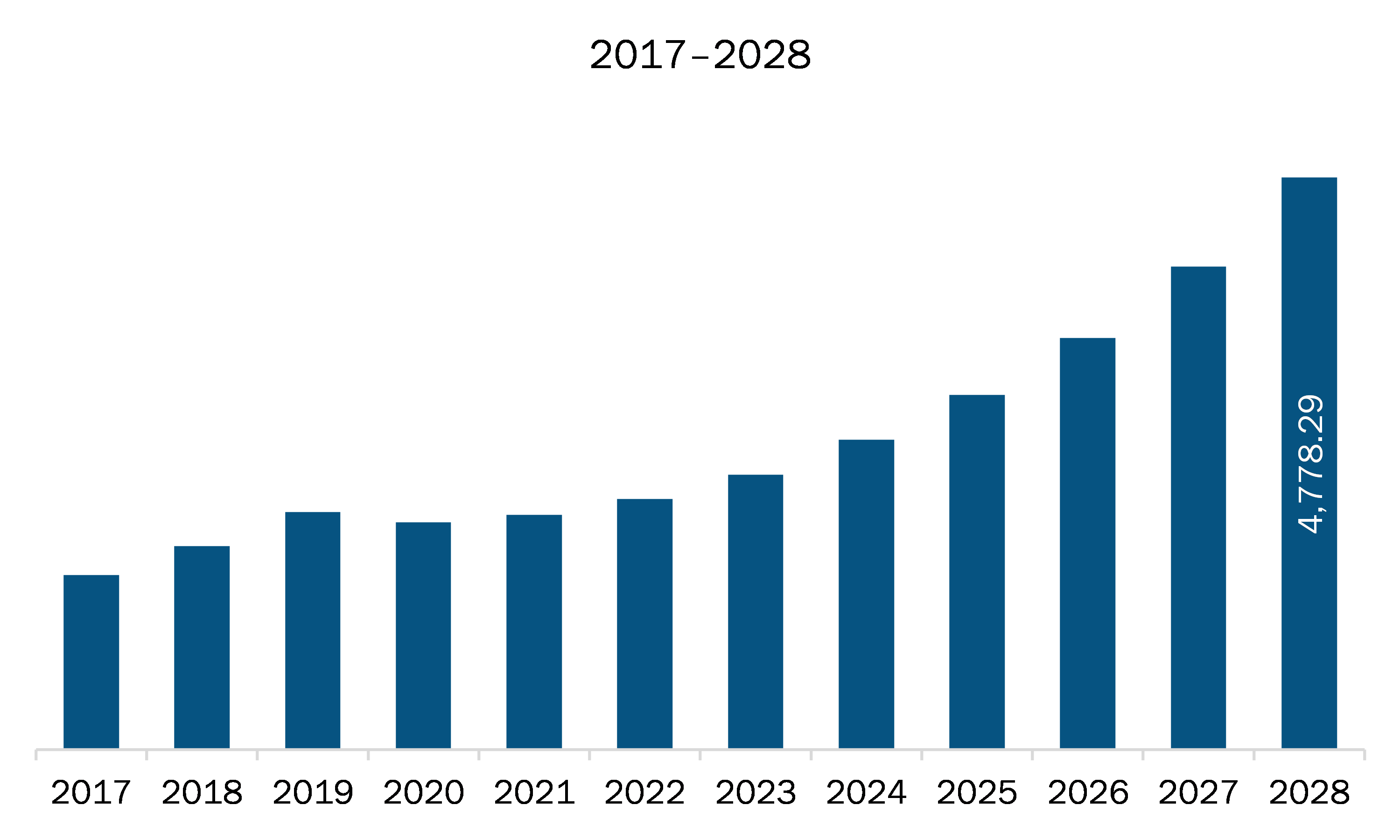The Europe smart mining market is expected to grow from US$ 1,961.62 million in 2021 to US$ 4,778.29 million by 2028; it is estimated to grow at a CAGR of 13.6% from 2021 to 2028.
The UK, Germany, France, Italy, and Russia are major economies in Europe. Increasing concern regarding data security is expected to drive the market growth. Data sources in the mining industry can be classified into two parts, namely, direct, or indirect (ancillary) measurements. Direct measurement sources are those taken by instruments such as GPS and conventional geodetic surveys. Indirect references refer to systems that collect data as a by-product of processes or operations such as Fleet Management Systems, SCADA or DCS data, blast hole drills, and geomodelling data. For improving ore recovery, an ore body modelling technique is used. The model provides geological patterns that help in determining the drill holes. The right mining decisions, therefore, depends on the availability of correct data from multiple systems combined with real-time data analytics. These decisions can be applied to mining production, exploration, and operations. They can also be used for monitoring and reporting metrics and KPIs. Additionally, they help in identifying root causes for operational bottlenecks such as unscheduled truck maintenance delays, long queuing time of trucks and LHDs, delays in lab samples undergoing quality control and batch processing, etc. Mining companies usually have confidential data, which needs to be protected during accidents and unpredicted natural hazards. Digitizing the mining processes may pave the way for hackers to access the network and regulate the operations of the mine. An effective way to protect the on-site data is by using on-site data acquisition systems that help prevent data, as their wireless network of geophysical sensors is concentrated in an area being tracked at the site. Smart mining systems collect and process their data on servers located / near the site, which are only connected to the network. This ensures that hackers are unable to access the system, and thus, provides data security. Therefore, growing security concerns will escalate the demand of smart mining, thereby driving the Europe market growth in coming years.
In case of COVID-19, Europe is highly affected specially France and Russia. In Europe, the COVID-19 pandemic has a different impact on different countries, as only selective countries have witnessed the rise in the number of cases and subsequently attracted strict, as well as prolonged, lockdown periods or social isolation norms. However, Western European countries such as Germany, France, Russia, and the UK have seen a comparatively modest decrease in their growth activities because of their strong healthcare systems. The of these countries have been investing significantly to make the diagnosis and treatment of the disease more effective and less time-consuming. According to the MDPI analysis, the impact on present mining production is modest, and the consequences are short-term in this case, owing to China's sustained high demand for minerals, which has offset reduced demand elsewhere in the globe. Stopping the exploration and development of new mines, on the other hand, will have long-term consequences, including a higher risk of future raw material supply disruptions. As a consequence, Europe's smart mining sector is expected to function smoothly in the next years.
With the new features and technologies, vendors can attract new customers and expand their footprints in emerging markets. This factor is likely to drive the Europe smart mining market. The Europe smart mining market is expected to grow at a good CAGR during the forecast period.

- This FREE sample will include data analysis, ranging from market trends to estimates and forecasts.
Europe Smart Mining Market Segmentation
Europe Smart Mining Market – By Component
- Hardware
- RFID Tags
- Sensors
- Intelligent System
- Others
- Software and Solution
- Logistics Software
- Data & Operation Management Software
- Safety & Security Systems
- Connectivity Solutions
- Analytics Solutions
- Remote Management Solutions
- Asset Management Solutions
- Services
Europe Smart Mining Market – By Mining Type
- Underground Mining
- Surface Mining
Europe Smart Mining Market, by Country
- France
- Germany
- Italy
- UK
- Russia
- Rest of Europe
Europe Smart Mining Market -Companies Mentioned
- ABB Ltd.
- Alastri
- Caterpillar Inc.
- Hexagon AB
- Hitachi, Ltd.
- Intellisense.io
- MineSense
- Rockwell Automation, Inc.
- SAP SE
- Trimble Inc.
Europe Smart Mining Report Scope
| Report Attribute | Details |
|---|---|
| Market size in 2021 | US$ 1,961.62 Million |
| Market Size by 2028 | US$ 4,778.29 Million |
| CAGR (2021 - 2028) | 13.6% |
| Historical Data | 2019-2020 |
| Forecast period | 2022-2028 |
| Segments Covered |
By Component
|
| Regions and Countries Covered |
Europe
|
| Market leaders and key company profiles |
|
- Historical Analysis (2 Years), Base Year, Forecast (7 Years) with CAGR
- PEST and SWOT Analysis
- Market Size Value / Volume - Regional, Country
- Industry and Competitive Landscape
- Excel Dataset
Recent Reports
Testimonials
Reason to Buy
- Informed Decision-Making
- Understanding Market Dynamics
- Competitive Analysis
- Identifying Emerging Markets
- Customer Insights
- Market Forecasts
- Risk Mitigation
- Boosting Operational Efficiency
- Strategic Planning
- Investment Justification
- Tracking Industry Innovations
- Aligning with Regulatory Trends





















 Get Free Sample For
Get Free Sample For